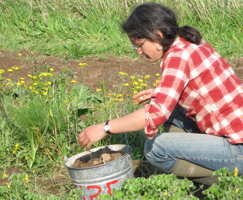~ Seed for GRAINS FOR HOME GROWERS ~
It is possible to grow some grain on a very small scale, without too much work - if you grow the right crops. This year we also have some Flax for you to try.
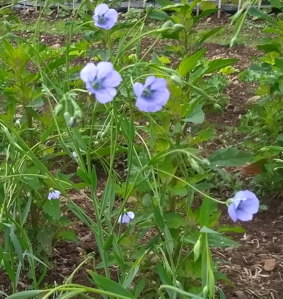
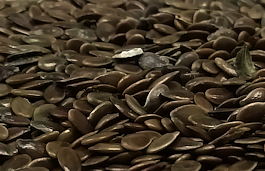
'Sussex Flax'
Flax also known as Linseed is grown both for fibre production (linen is woven from flax fibre) and for the oil rich seeds. Commercially these are processed into oil for food and other uses.
This variety grows around 1m tall & produces large numbers of gorgeous dark golden brown seeds which you can use toasted in flapjacks, sprinkled on your porridge etc.
Flax plants make beautiful clear blue flowers and are great planted in drifts as a cottage garden ornamental and also for cutting.
Sow in March / early April.
Easy to grow both for the flowers and the edible seed.
 approx 200 seed, organic
£
approx 200 seed, organic
£
~ Amaranth as a grain ~
 Quinoa and amaranth are technically 'pseudograins', as they're not from grasses. They're a much better choice for home or allotment growers though compared to traditional grains like wheat or oats, as they produce better on a small scale and are easier to harvest & process without specialist equipment.
Quinoa and amaranth are technically 'pseudograins', as they're not from grasses. They're a much better choice for home or allotment growers though compared to traditional grains like wheat or oats, as they produce better on a small scale and are easier to harvest & process without specialist equipment.
The two are sown and harvested similarly - see the packet and your invoice for full details, as well as the harvest instructions in our reference section.
Small screen: Turn your device sideways to view sowing calendar.






















































 = normal sowing & harvest time
= normal sowing & harvest time![]()
 = also possible depending on conditions
= also possible depending on conditions
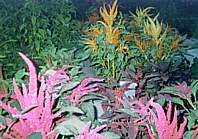
'Mixed Grain Amaranths'
These make up to 200,000 seed per plant, are very easy to thresh. The seeds don't need grinding - you just add them to whatever you are cooking.
This is our own special mixed population bred from our trials - we have been working on this for about 20 years now. It produces early, and gives a good yield of seed that is easily threshed.
Very filling and nutritious, we add it to rice when cooking, it adds both flavour and protein. Simple harvesting instructions supplied.
Start from late April in pots as though tomatoes, & plant out when bigger - they are very robust once six inches tall and romp away even in cool weather.
3-4ft tall mix. Spectacular red - pink - yellow flowers. High-yielding and early.
 200 seed, organic
£
200 seed, organic
£
~ Growing QUINOA as a grain ~
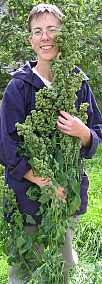 Quinoa is a high-protein grain you can easily grow at home. It is cooked just like rice, and as well as tasting good, it is rich in lysine, giving a good nutritional balance to your meal.
Quinoa is a high-protein grain you can easily grow at home. It is cooked just like rice, and as well as tasting good, it is rich in lysine, giving a good nutritional balance to your meal.
The grain is naturally protected from insects, rodents and birds by a yellow soapy coating that tastes bitter. This is easily removed – by soaking the seed overnight to soften the soap, then rubbing it and rinsing several times in cold water before cooking.
It's no more hassle than soaking dried beans before you use them, and means that you lose less of the crop to the beasties in your garden.
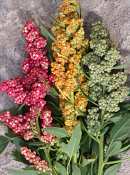 'Rainbow' Quinoa
'Rainbow' Quinoa
This is a diverse population of different colours all selected for an open flower-shape that sheds water easily and helps grow good seed even in slightly damper climates (like, for example, the west coast of Wales where we are . . .)
Note that at first you might question the name - as it starts to grow, it seems to be just different shades of green. But wait patiently! As the seed ripens, they do indeed go all different colours, making an impressive display.
It does very well for us, reaching about 6 feet tall by the end of July, even in colder years. The plants flower in July/August, and seed is ready in Sept/Oct.
Bred for home gardeners.

 1.5 g - lots of tiny seed, organic
£
1.5 g - lots of tiny seed, organic
£
'Temuco'
Quinoa 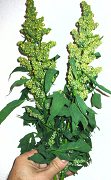

From South America, & has very open seed-heads that help shed the rain. A good choice for the wetter or windier parts of the UK, we find that this is always a heavy producer.
Quinoa seeds are yellow when harvested (see picture) and are just soaked in water to remove the coating of natural saponins before cooking (otherwise they taste 'soapy'). This is why bought seed is white - it's been pre-washed for you. The advantage of this 'soapiness' is that it puts off the birds from eating the seed, so less need for netting or small boys throwing stones!
Both drought and wet tolerant. Instructions for seed collection included but it's pretty simple!
 at least 200 seed, organic
£
at least 200 seed, organic
£
Our Super- Detailed
Quinoa Harvest Instructions:
This may make it sound complicated but it really isn't. We've added these very detailed instructions for those of you who have never tried this sort of thing before.
To collect seed: Once the seed starts to form and the flowerheads start to change colour , you'll notice if you rub the flowerheads with your palms, some seed can be rubbed out easily. It's now time to cut the heads and put somewhere airy to wilt, then beat out over a bowl. Do not leave the seeds too long on the plant or they will germinate in-situ! Different varieties will cross if grown at the same time, but you might not care about that - you can let them cross and you'll end up with your own particular new variety.
We actually hang the cut flowerheads up to dry out a bit for a few days after cutting - it makes the seeds come loose as the plant wilts. You can lay them on a sheet instead, but if lying on a sheet, turn the heads frequently to stop them going mouldy. Good airflow at low temperatures is the key to avoiding mould. Removing leaves and big bits of stem really helps with this too.
If it's all going mouldy or won't dry much, or you get bored of waiting for it to dry, don't worry, just go on to the next step: To actually get the seeds off the heads, we wear rubber gloves and rub the heads between our palms, which knocks out the seeds, although quite a lot of other bits come off too.
Then pass the whole mess through a garden riddle (1/4 or 1/2 inch mesh) to get rid of the big bits. (If you don't have a riddle, pick out the big bits by hand.) Seeds and flowers should fall through the riddle. Either bin or re-rub the big stuff left behind.
Now you should have a pile of seeds in their flower bracts that is a bit dry but still needs drying further. Spread it out in a thin layer on a tea-tray or baking tray, and put somewhere to dry. A quick stir as you pass each day will make sure it all dries well. Once dry the seed can be easily rubbed out of the flowers (gloves again) and then winnowed with 2 buckets.
(PS: Don't know what winnowing is? See 'Threshing and Winnowing' under 'SeedSaving' in the side-bar to the left.)
Quinoa COOKING:
Quinoa seed is covered in a coating of yellow/brown saponins (natural soap) the plant makes to protect it from insects. This should be washed off before cooking, or it will be bitter.
This is very easy; soak a cupful of seed for 24h in a bowl of water, to soften the soap. Then to get it off, drain off most of the water and rub the seed well between your palms or fingers, it will froth up and go paler as the soap comes off as the seeds rub against each other.
Now fill the bowl with fresh water for a rinse. Swirl and drain. Rinse several more times until the water doesn’t froth up any more. (If necessary , repeat the rubbing).
Now it’s ready to cook. This all takes less time to do than read about! Once clean, just boil as though rice (perhaps a few mins longer). We often put 30% quinoa seed in with our rice and cook it all together; quinoa is rich in the amino acid Lysine and so makes rice a ‘complete protein’ when added to it.






